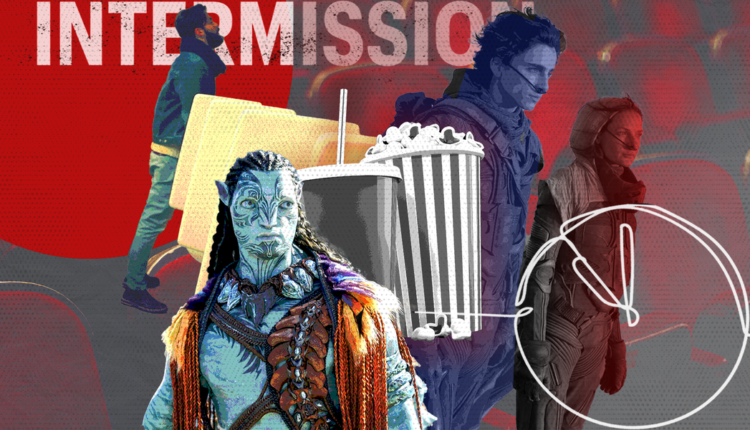IT’S OSCAR season, and for movie fans, that means heading down to theaters (or slumping into the deep excesses of the couch) to check Best Picture nominees off the deep abyss of your to-watch list. But this year’s nominees, combined, will take around 24 hours to watch; I don’t know about you, but that feels like a bit more than a usual weekend binge to me. The longest of them, James Cameron’s Avatar: The Way of Water—which runs at a more-than-healthy 3 hours and 12 minutes—will undoubtedly have you squirming in your seat and checking your phone for the time at least once or twice. Even if you’re blissfully enjoying yourself, sitting continuously for hours can be adverse to your health, and staring at a bright television screen can be hard on the eyes. While at home, you can control everything about your viewing experience: pause for a bathroom break, skip through parts when you’re bored, turn the volume up or down. But at the movie theater? A trip to the bathroom means missing out on the film you’ve paid good money to see. That’s why it’s time to bring back a practice from moviegoing days of yore. It’s time to bring back intermissions.
First, a quick history lesson. As a 2014 Slate piece in defense of the intermission explains, a midway break was commonplace in cinemas back when theaters needed time to switch out reels. After reels were no longer needed, theaters kept intermissions going to give audiences a break, but eventually phased them out in lieu of packing more screenings into each day. According to SFGate, the last official movie to have an intermission in the U.S. was Gandhi in 1982.
And although, as CNN reports, it’s hard to say for sure whether all movies are getting longer, it’s clear to see that the blockbusters audiences are drawn to have been boasting increasingly meaty runtimes. Denis Villeneuve’s 2021’s sci-fi epic Dune clocks in at 2 hours and 35 minutes, and the DC and Marvel superhero flicks The Batman and Black Panther: Wakanda Forever run for a whopping 2 hours and 56 minutes and 2 hours and 41 minutes, respectively. If you’re going to sit for a cinematic experience that lasts more than 2 hours (some pushing 3), why not set aside a ten minute or so break to go to the bathroom or get a refill on that giant Coca-Cola?
Movie theaters are suffering from an identity crisis right now. The rise of streaming services has made it easier than ever to avoid heading to the movies, just as ticket prices have increased with theaters struggling to break even. Plus, audiences don’t feel the same incentive to head out to the theater to see a movie, knowing they’ll likely be available to watch at home sooner than ever, following what has now for most films become a brief theatrical visit.
To stay afloat, The New York Times reports movie theaters are changing their standard pricing models. CNBC reports they’re improving seating and projection quality, hosting events, and offering more food and beverage options. But it’s still too soon to say if these kinds of changes will be enough to keep people coming back. Hopefully, they are. But why not add one more helpful piece to the moviegoing puzzle and bring back the intermission too?
Musicals and plays have intermissions. Granted, they’re most useful for the many hardworking crew members behind the scenes to take a break and prepare for the rest of the performance. But audience members value that time as well, hitting the bathroom, taking phone calls, getting another cocktail, or just chatting with companions about the first half of the show. It adds to the overall experience, and it’s a welcomed relief for both the crew and the audience. Hell, if you get a little break and realize you’re not enjoying a movie, you could even take the intermission as an opportunity to reclaim your time and head home early. Life is short, baby.
Still, theaters and industry insiders aren’t so sure. A USA Today article says intermissions aren’t coming back anytime soon, as movie theater experts say they both waste time and money and cut into directors’ visions. The argument continues: people are more than willing to binge hours of Stranger Things nonstop, so what’s one three-hour movie?
That’s not quite the right perspective. An intermission could, in fact, have major economic impact on movie theaters—in a good way. It’s, in essence, a chance for theatergoers to go for “seconds”, bringing more money to the theater than the initial mad dash audience members usually make between the box office or ticket kiosk and settling into their seats. All we need is 10 to 20 minutes, which is no time at all, comparatively, when you’ve already sat down for a 2 hour and 30 minute movie.
As for directors’ visions, it’s perfectly understandable that filmmakers won’t like knowing their masterpieces could be interrupted with a largely-blank screen otherwise urging patrons to take a quick pee break. But there’s no harm in directors designing a movie to have an intermission whenever it would feel most appropriate. The audience will thank you. Then again, James Cameron told The Hollywood Reporter that he didn’t mind if people needed to step out during Avatar: The Way of Water for a bathroom break: “They can see the scene they missed when they come see it again.”
I’d argue intermissions didn’t stop moviegoers from watching classics like Gone with the Wind (3 hours and 58 minutes), Ben-Hur (3 hours and 32 minutes), or Lawrence of Arabia (3 hours and 42 minutes). And although it didn’t have an actual intermission, Vulture recalls Titanic had intermissions put in by theaters due to the length of the film (sorry, again, to James Cameron). To this day, many critics still consider the above films masterpieces, despite intermissions chopping them in half. Movie fans of a certain age may even recall seeing some longer films in VHS form, where they were split into not one but two different cassette tapes. Same idea, right? In fact, it may have even been a more enjoyable experience for original filmgoers who weren’t keeping their bladders at bay the whole time. If directors want people to immerse themselves in the worlds they’ve created, it makes sense to allow them a reprieve.
As for the binging argument… let’s be serious. When binging Wednesday or Stranger Things or whatever the hottest show of the moment is, no one is watching hours and hours of television without breaking for a snack, taking a bathroom break, folding laundry, texting friends, or pursuing any other combination of regular tasks people do in their own homes. Sitting in the same position in a dark room while watching the entirety of Peter Jackson’s Lord of the Rings trilogy (which boasts an 11 hour runtime) would make even the most devoted fan fidgety.
Going to the movie theater is a cherished experience for families, a way to give teens something to do on a Saturday afternoon, and a regular hobby for film lovers across the country. Movie theaters are an institution for those of us who want to take in both exciting blockbusters and pieces of great art, and also feel like we can be part of the ongoing cultural conversation. So to movie theater owners, filmmakers, and everyone who has a stake in the moviemaking business, it’s time to make a push for intermissions.
For the sake of movie theaters’ longevity. For the sake of filmgoers. And, come on, for the sake of our bladders. Bring the intermission back. We’ll be waiting—whether it feels as long as a James Cameron masterpiece or not.

Milan Polk is an Editorial Assistant for Men’s Health who specializes in entertainment and lifestyle reporting, and has worked for New York Magazine’s Vulture and Chicago Tribune.




Comments are closed.